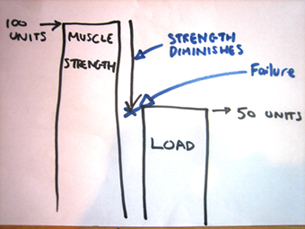 A lot of people are avoiding the most productive rep in a set because of an undue fear of injury.
A lot of people are avoiding the most productive rep in a set because of an undue fear of injury.
In my last post I put forward the case for continuing a set until muscular failure when the goal is to maximize muscular growth.
However, you may have heard it said that training to failure is unsafe.
There is a fear of going to failure in some circles because they feel the last rep or 2 of a set is the most dangerous. They believe that they are in danger of tearing their tendons by working at this level of intensity.
But is this fear justified? I’ve created a video to answer the question, check it out. I’ve summarized the points below.
- Because of the intensity, fatiguing of fibers, and lactic acid build up, there’s the perception that this last rep is dangerous and can lead to injury.
- This feeling/perception is totally unrelated to the safety of the exercise.
- The key to understanding this is the difference between the strength levels of the muscles and the connective tissues.
- As you progress in a set towards failure, your muscle strength levels diminish. So each successive rep gets increasingly more difficult to execute.
- However, the level of force the tendons can withstand remains constant throughout the set.

- Once your strength levels dip below 50 units (in the above diagram), you’ve reached failure. It’s completely impossible to complete another rep. That last rep forced you to use 100% of your momentary muscular ability.
- Here’s the difference with tendons: tendons are not elastic like muscle. They are strong, fibrous tissue. If you have a tendon that can withstand 150 units of force, it will still withstand this force as much on the last rep as the first rep.
- You CAN damage connective tissue with sudden, jerking movements. Also, attempting to lift a load which forces the tendons to deal with a force beyond that which they can handle will probably lead to a tear.
So don’t fear failure!
Your Buddy,
Mark
P.S. If you found the video useful, please go to the YouTube page and rate up. Thank you 🙂

I like the graph.
thanx mark that was great!! make some more videos, makes much more sense when i can hear it.
Thanks. Yes, I’ll be making more, Jason.
Mark,
How long (# of weeks) does you body typically allow you to take work sets to failure, before you begin to feel the affects of over training?
What a great video – to the point and easy to understand!
Thanks for being such a great resource for all of us, Mark!
@Scott. This is more of a concern for those who work the same muscle group to failure more than once a week. By the time I hit the same muscle to failure, it’s had 7 days of recovery. However, I do take a full week off every 10 weeks to be on the safe side.
@Adam. I appreciate that mate, thank you.
Mark, keep on making the videos. Maybe do some work out videos we can follow along with. It would be great motivation for those of us who workout alone.
Have had lower back surgery year and a half ago and I wonder if you can recommend exercises that fit into your five day program?
sexy accent man!!!
Hi Mark, another great article, thanks mate 🙂
I was just wondering, do you work out alone or with somebody? Because my greatest reluctance to go for “one more rep” on some exercises (squats, overhead press, incline barbell bench, etc) is for fear of the bar crashing down on me if I over-cook it without a spotter. I don’t have a power rack in my gym unfortunately, and there isn’t always anyone there to spot.
Cheers, keep on posting these articles mate, great morivation.
Rich
You read my mind…
I’m 57 and there is a little voice telling me that I’m too old to train to failure.
I also had the thought that, as you said, training to failure will cause me to tear a tendon or ligament (not sure which bits a tendon and which bit is a ligament).
Some great helpful info here.
By the way Mark… I like your style on the video and a super Irish accent.
Any special advice for we over 50’s? I’m sure lots of the muscle hackers out there are in that age group.
nice concept i tried 1 of your concept yesterday(continue until you cant do no more) and i must say i dun noe i still have so much under my belt!!! however i have a stupid question: when should i consume my post workout protein shake??? because 10 min is post workout 24 hrs also post workout…
I’m with Rich. I’ve never worried about overworking my tendons; “safety” to me means not getting trapped under the bar (e.g. in a bench press) or having my form fall into an unsafe position (e.g. rounding my lower back on a deadlift) due to lack of strength. I still do train to failure where possible, and have found some creative ways to make it safe (e.g. bench to near failure then immediately drop into pushups until failure). On deadlifts I typically only do singles at heavy weights to make sure I can focus on perfect form with each rep and don’t get lazy with my back.
@Ray. Thanks and yes I’ll be making more workout videos.
@Donnie. I wouldn’t want to advise you on that to be honest, I don’t specialize in rehabilitation.
@Loader. Thank You.
@Rich. Cheers. I workout alone, but I do have a rack so I can squat and bench until I can do no more. You shouldn’t have a problem overhead pressing to failure without a rack though. You shouldn’t have to clean it from the floor though as it would expend too much energy before the set has even started.
@Keith. I have so many readers in their 40s and 50s. I don’t have any special advice though because the stimulus required (external) and biochemical changes (internal) that result in growth are the same for us all.
@wad. Immediately is best.
@Rich. You might want to invest in a rack or find a gym that has one, makes life a lot easier.
Mark
bicep tht yesterday, kinda sore today… guessing it is no biggie after reading this post!!